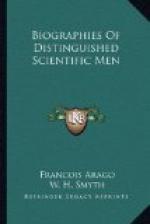Leibnitz conferred upon this hypothesis the honour of appropriating it to himself. He attempted to deduce from it the mode of formation of the different solid envelopes of which the earth consists. Buffon, also, imparted to it the weight of his eloquent authority. According to that great naturalist, the planets of our system are merely portions of the sun, which the shock of a comet had detached from it some tens of thousands of years ago.
In support of this igneous origin of the earth, Mairan and Buffon cited already the high temperature of deep mines, and, among others, those of the mines of Giromagny. It appears evident that if the earth was formerly incandescent, we should not fail to meet in the interior strata, that is to say, in those which ought to have cooled last, traces of their primitive temperature. The observer who, upon penetrating into the interior of the earth, did not find an increasing heat, might then consider himself amply authorized to reject the hypothetical conceptions of Descartes, of Mairan, of Leibnitz, and of Buffon. But has the converse proposition the same certainty? Would not the torrents of heat, which the sun has continued incessantly to launch for so many ages, have diffused themselves into the mass of the earth, so as to produce there a temperature increasing with the depth? This a question of high importance. Certain easily satisfied minds conscientiously supposed that they had solved it, when they stated that the idea of a constant temperature was by far the most natural; but woe to the sciences if they thus included vague considerations which escape all criticism, among the motives for admitting and rejecting facts and theories! Fontenelle, Gentlemen, would have traced their horoscope in these words, so well adapted for humbling our pride, and the truth of which the history of discoveries reveals in a thousand places: “When a thing may be in two different ways, it is almost always that which appears at first the least natural.”
Whatever importance these reflections may possess, I hasten to add that, instead of the arguments of his predecessors, which have no real value, Fourier has substituted proofs, demonstrations; and we know what meaning such terms convey to the Academy of Sciences.
In all places of the earth, as soon as we descend to a certain depth, the thermometer no longer experiences either diurnal or annual variation. It marks the same degree, and the same fraction of a degree, from day to day, and from year to year. Such is the fact: what says theory?
Let us suppose, for a moment, that the earth has constantly received all its heat from the sun. Descend into its mass to a sufficient depth, and you will find, with Fourier, by the aid of calculation, a constant temperature for each day of the year. You will recognize further, that this solar temperature of the inferior strata varies from one climate to another; that in each country, finally, it ought to be always the same, so long as we do not descend to depths which are too great relatively to the earth’s radius.




